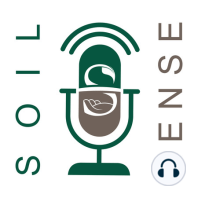37 min listen
Soilborne Diseases with Audrey Kalil, Ph.D.
FromSoil Sense
ratings:
Length:
21 minutes
Released:
May 3, 2021
Format:
Podcast episode
Description
As with any biological system, there can be good microbes, and there can also be harmful microbes. Crop and soil health is certainly no exception. In this episode we will discuss some of the soilborne pathogens that are impacting crops, with a special focus on pulse crops (peas, lentils, and chickpeas).
Dr. Audrey Kalil, a plant pathologist at the North Dakota State University Williston Research Extension Center joins us. Audrey’s research focuses on common crops in the region, which is a pretty dry area, so crops like spring wheat, durum wheat, canola, and pulse crops. Most of her work is in looking at soilborne diseases. But Audrey didn’t always set out to study diseases. In fact, her PhD work focused on the beneficial nitrogen-fixing types of bacteria. It also explains how she found a particular interest in pulse crops.
“I think there are a lot of natural intersections between the concepts of soil health and disease management.” - Dr. Audrey Kalil
Dr. Kalil shares how pulse crops through cover crop usage and rotation strategies can help many operations. She goes on to share the necessity and advantage of providing a “robust microbial ecosystem” to help your soils not become burdened by any one pathogen or disease. Dr. Kalil highlights that some crops overlap with pathogens they may promote for example peas and lentils. The overlapping characteristics of these species can lead to an overgrowth of some soil pathogens that will become more difficult to manage overtime. She offers different management strategies and seed treatments to avoid these overgrowth situations.
Dr. Kalil explains the disease triangle as a concept to better understand crop disease management. There are three main pillars to developing crop disease including the presence of the pathogen in your area, the variety of crop and its level of susceptibility and the effects of weather. Managing and manipulating any one of these pillars can lead to a lower crop disease burden and his a helpful way to address these concerns.
This Week on Soil Sense:
Meet Dr. Audrey Kalil, a plant pathologist at the North Dakota State University Williston Research Extension Center
Discover what advantages nitrogen fixation bacteria can offer different operations
Learn how to encourage biodiversity in the soil microbial heath as a soilborne pathogen deterrent
Explore they many different techniques available to manage crop disease
Learn more about pulse crops by listening to the Growing Pulse Crops Podcast
Connect with Soil Sense:
Soil Sense Initiative
Soil Sense Podcast is hosted by Tim Hammerich of the Future of Agriculture Podcast.
Dr. Audrey Kalil, a plant pathologist at the North Dakota State University Williston Research Extension Center joins us. Audrey’s research focuses on common crops in the region, which is a pretty dry area, so crops like spring wheat, durum wheat, canola, and pulse crops. Most of her work is in looking at soilborne diseases. But Audrey didn’t always set out to study diseases. In fact, her PhD work focused on the beneficial nitrogen-fixing types of bacteria. It also explains how she found a particular interest in pulse crops.
“I think there are a lot of natural intersections between the concepts of soil health and disease management.” - Dr. Audrey Kalil
Dr. Kalil shares how pulse crops through cover crop usage and rotation strategies can help many operations. She goes on to share the necessity and advantage of providing a “robust microbial ecosystem” to help your soils not become burdened by any one pathogen or disease. Dr. Kalil highlights that some crops overlap with pathogens they may promote for example peas and lentils. The overlapping characteristics of these species can lead to an overgrowth of some soil pathogens that will become more difficult to manage overtime. She offers different management strategies and seed treatments to avoid these overgrowth situations.
Dr. Kalil explains the disease triangle as a concept to better understand crop disease management. There are three main pillars to developing crop disease including the presence of the pathogen in your area, the variety of crop and its level of susceptibility and the effects of weather. Managing and manipulating any one of these pillars can lead to a lower crop disease burden and his a helpful way to address these concerns.
This Week on Soil Sense:
Meet Dr. Audrey Kalil, a plant pathologist at the North Dakota State University Williston Research Extension Center
Discover what advantages nitrogen fixation bacteria can offer different operations
Learn how to encourage biodiversity in the soil microbial heath as a soilborne pathogen deterrent
Explore they many different techniques available to manage crop disease
Learn more about pulse crops by listening to the Growing Pulse Crops Podcast
Connect with Soil Sense:
Soil Sense Initiative
Soil Sense Podcast is hosted by Tim Hammerich of the Future of Agriculture Podcast.
Released:
May 3, 2021
Format:
Podcast episode
Titles in the series (100)
Intercropping and Soil Health by Soil Sense
